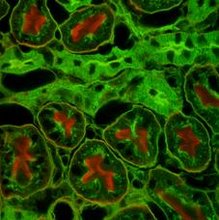
Practical 1: AIM: To study the enzyme kinetic using HRP .
PRINCIPLE:
Enzymes are the reaction catalysts of biological systems. They have high degree of specificity for their substrate. Enzymes function in aq. Solution under very optimum / mild conditions of temp. And pH.
The study of reaction rates and the influence of changes in environmental factors (such as temperature, pH etc.) are known as kinetics. Enzyme kinetics is that branch of enzymology, which deals with factors affecting rates of enzymes- catalyzed reactions. The most important factors are as follows
1) Enzyme concentration
2) Substrate concentration
3) Temperature
4) pH
When the effects of these factors are analyzed carefully, they give information regarding the order in which the substrates add to the enzymes and products formed.In this experiment, an oxygen atom is transferred to an acceptor molecule, which in this case is the organic molecule guaiacol.this reaction is enhanced by the enzyme peroxidase. Hydrogen peroxidase and guaiacol are both substrates. The specific reaction is
PRINCIPLE:
Enzymes are the reaction catalysts of biological systems. They have high degree of specificity for their substrate. Enzymes function in aq. Solution under very optimum / mild conditions of temp. And pH.
The study of reaction rates and the influence of changes in environmental factors (such as temperature, pH etc.) are known as kinetics. Enzyme kinetics is that branch of enzymology, which deals with factors affecting rates of enzymes- catalyzed reactions. The most important factors are as follows
1) Enzyme concentration
2) Substrate concentration
3) Temperature
4) pH
When the effects of these factors are analyzed carefully, they give information regarding the order in which the substrates add to the enzymes and products formed.In this experiment, an oxygen atom is transferred to an acceptor molecule, which in this case is the organic molecule guaiacol.this reaction is enhanced by the enzyme peroxidase. Hydrogen peroxidase and guaiacol are both substrates. The specific reaction is
The progress of this reaction is reflected by the appearance of brown color in reaction mixture due to the formation of guaiacol oxide.
PROCEDURE:
Step 1:standard / base line testAdd the reagents in the tubes as follows.
PROCEDURE:
Step 1:standard / base line testAdd the reagents in the tubes as follows.
2.adjust the reading to zero absorbance with tube 1 blank and start the reaction by adding 800ul of HRP solution to tube 2 and read the absorbance of the mixture at 470 nm at every 30seconds interval for 3 minutes.
3. Enter the reading as shown in the result.
Step 2:enzyme kinetics
EFFECT OF PH:
AIM: To study the effect of pH on enzyme HRP (horse reddish peroxidase) at
room temperature.
1.Perform four tests by varying the pH of the buffer which is 3, 5, 7and 9
Measure the absorbance at 470 nm at every 30 sec for the interval of 3 minutes.
2.prepare different blanks for different sets of Ph experiment.
Add the regents in tubes as shown in table for diff pH.
3. Enter the reading as shown in the result.
Step 2:enzyme kinetics
EFFECT OF PH:
AIM: To study the effect of pH on enzyme HRP (horse reddish peroxidase) at
room temperature.
1.Perform four tests by varying the pH of the buffer which is 3, 5, 7and 9
Measure the absorbance at 470 nm at every 30 sec for the interval of 3 minutes.
2.prepare different blanks for different sets of Ph experiment.
Add the regents in tubes as shown in table for diff pH.
INTERPRETATION:
Enzyme activity is pH dependent. It is found from experiment that absorbance is maximum at optimum pH, which is 5. At extreme pH activity of HRP found to be decreased.
EFFECT OF ENZYME CONCENTRATION:
AIM: To study the effect of enzyme concentration on reaction kinetics at room temperature.
PROCEDURE:
STEP 2Add the reagents in the tubes as follows.
Enzyme activity is pH dependent. It is found from experiment that absorbance is maximum at optimum pH, which is 5. At extreme pH activity of HRP found to be decreased.
EFFECT OF ENZYME CONCENTRATION:
AIM: To study the effect of enzyme concentration on reaction kinetics at room temperature.
PROCEDURE:
STEP 2Add the reagents in the tubes as follows.
Measure the absorbance at 470 nm at every 30 sec for the interval of 3 minutes.
Result:
Result:
CHART:
INTERPRETATION:
When substrate concentration held constant and amt. Of enzyme varied a linear increase or decrease in activity rate was observed.
EFFECT OF TEMPERATURE
AIM: To study the effect of temperature on reaction kinetics of HRP.
PROCEDURE:
Perform 5 tests at different temperature like 8 °C, RT, 80 °C.Add the reagents in the tubes as follows.
When substrate concentration held constant and amt. Of enzyme varied a linear increase or decrease in activity rate was observed.
EFFECT OF TEMPERATURE
AIM: To study the effect of temperature on reaction kinetics of HRP.
PROCEDURE:
Perform 5 tests at different temperature like 8 °C, RT, 80 °C.Add the reagents in the tubes as follows.
Measure the absorbance at 470 nm at every 30 sec for the interval of 3 minutes.
RESULT:
RESULT:
INTERPRETATION:The rate of enzyme catalyzed reaction increases with temperature. The reaction rate approximately doubles for 10-15 °C rise in temperature. However the thermal denaturation sets as the temperature is raised so as the temperature is raised the rate passes through a maximum and then falls.


No comments:
Post a Comment